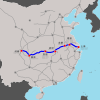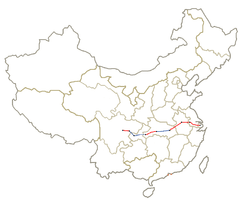Shanghai–Wuhan–Chengdu high-speed railway
| Shanghai–Wuhan–Chengdu high-speed railway | |||||||
| Simplified Chinese | 沪汉蓉快速客运通道 | ||||||
|---|---|---|---|---|---|---|---|
| Traditional Chinese | 滬漢蓉快速客運通道 | ||||||
| |||||||
Shanghai–Wuhan–Chengdu high-speed railway (Chinese: 沪汉蓉快速客运通道), is a fully completed high-speed railway corridor operated by China Railway High-speed. The Chinese name of the railway line, Huhanrong, is a combination of the abbreviations for Shanghai (沪, Hù), Wuhan (汉, Hàn), and Chengdu (蓉, Róng), three major cities along the line.
The Shanghai–Wuhan–Chengdu passenger-dedicated line is one of the four east–west high-speed rail corridors outlined in China's national high-speed rail plan. From east to west, it will connect the major cities of Shanghai (a provincial-level municipality), Nanjing (the capital of Jiangsu), Hefei (the capital of Anhui), Wuhan (the capital of Hubei), Chongqing (a province-level municipality), and Chengdu (the capital of Sichuan). The total population of the four provinces and two municipalities served by this rail line is over 320 million (as of 2008).[1]
Despite its name, the line is actually a medium-speed railway designed to run at a maximum speed of 200 km/h (120 mph) in most sections. The newer Yangtze River passageway, running parallel to it at 350 km/h (220 mph), is being planned to manage the increasing passenger traffic.
Components
All sections are now operational.
Operational lines are marked with green background.
| Section | Description | Designed speed (km/h) |
Length (km) |
Construction start date |
Open date |
|---|---|---|---|---|---|
| Shanghai–Wuhan–Chengdu high-speed railway  |
HSR Corridor through the Yangtze Valley consisting of an intercity railway line, and 7 mixed-use HSR segments connecting Nanjing, Hefei, Wuhan, Yichang, Lichuan, Chongqing, Suining & Chengdu. | 350-200 | 2078 | 2003-12-01 | 2014-07-01 |
| Shanghai–Nanjing section (Shanghai–Nanjing Intercity Railway) |
HSR connecting Shanghai and Nanjing | 350 | 301 | 2008-07-01 | 2010-07-01 |
| Nanjing–Hefei section (Hefei–Nanjing Passenger Railway) |
Mixed passenger & freight HSR connecting Nanjing & Hefei | 350 | 166 | 2005-06-11 | 2008-04-18 |
| Hefei–Wuhan section (Hefei–Wuhan Passenger Railway) |
Mixed passenger & freight HSR connecting Hefei & Wuhan | 350 | 351 | 2005-08-01 | 2008-12-31 |
| (Wuhan)Hankou–Yichang section (Hankou-Yichang Railway) |
Mixed passenger & freight HSR connecting Wuhan & Yichang | 200 | 293 | 2008-09-17 | 2012-07-01 |
| Yichang–Lichuan section (Yichang-Wanzhou Railway) |
Mixed passenger & freight HSR connecting Yichang & Lichuan[2] | 200 | 377 | 2003-12-01 | 2014-07-01 |
| Lichuan–Chongqing section (Chongqing-Lichuan Railway) |
Mixed passenger & freight HSR connecting Lichuan & Chongqing | 200 | 264 | 2008-12-29 | 2013-12-28 |
| Chongqing–Suining section (Suining-Chongqing Railway) |
Mixed passenger & freight HSR connecting Chongqing & Suining | 200 | 132 | 2009-01-18 | 2009-9-29 |
| Suining–Chengdu section (Dazhou-Chengdu Railway) |
Mixed passenger & freight HSR connecting Suining & Chengdu. | 200 | 148 | 2005-05 | 2009-06-30 |
Shanghai–Nanjing
From Shanghai to Nanjing, the line is called the Shanghai–Nanjing Intercity Railway. The Shanghai-Nanjing Intercity Railway opened on July 1, 2010. It has a designed operating speed of 350 km/h (220 mph). Shanghai is an important railway hub, also serving as the terminus of the Beijing–Shanghai high-speed railway, which is a high-speed railway that parallels all of this section, as well as the Shanghai–Kunming high-speed railway.
Nanjing to Hefei
From Nanjing to Hefei, the line is called the Hefei–Nanjing Passenger Railway. The Hefei–Nanjing Passenger Railway is shared with the Nanjing–Xi'an Railway. It has a designed speed of 250 km/h (160 mph). At Hefei, a connection is available to the Hefei–Bengbu high-speed railway, which is a branch line of the Beijing–Shanghai high-speed railway.
Hefei to Wuhan
From Hefei to Wuhan, the line is called the Hefei–Wuhan Passenger Railway, with a designed speed of 250 km/h (160 mph). At Wuhan, a connection is available to the Beijing–Guangzhou–Shenzhen–Hong Kong high-speed railway, an important north-south railway line from Beijing to Guangzhou and Kowloon, Hong Kong.
Wuhan to Yichang
From Wuhan to Yichang, the line is called the Wuhan–Yichang Railway.
Yichang to Chongqing
Yichang–Wanzhou Railway
The Yichang–Wanzhou Railway connects the cities of Yichang, Lichuan, and Wanzhou. The Shanghai–Wuhan–Chengdu Passenger Dedicated Line only uses the Yichang to Lichuan portion of the Yichang–Wanzhou Railway. (The actual spliting point of Yichang-Wanzhou and Chongqing-Lichuan railways is Liangwu Railway Station)
Unlike other sections of the Shanghai-Chengdu railway, as of the beginning of 2014 the Yichang–Lichuan–Wanzhou does not yet have proper high-speed train service (D- or G-series). It is used extensively by "conventional" passenger trains (with the T-series being the fastest). The delay with the introduction of the high-speed service on this section is explained by the need to integrate signalling and other infrastructure. Regular CRH services between Chongqing and Wuhan is expected to commence on July 1, 2014, after renovations and other associated high-speed rail works are completed.[3] [4] However, the opening of high-speed service (as opposed to "regular" trains) on the Yiwan line won't happen until July 1, 2014.[5]
Chongqing–Lichuan Railway
At Lichuan, the Chongqing–Lichuan Railway connects it with the city of Chongqing.
Chongqing to Chengdu
Suining–Chongqing Railway
The Suining–Chongqing Railway connects the cities of Chongqing and Suining. Its designed operating speed is 200 km/h (120 mph).
Dazhou–Chengdu Railway
The Dazhou–Chengdu Railway is a railway connecting the cities of Dazhou, Suining, and Chengdu. The Shanghai–Wuhan–Chengdu Passenger Dedicated Line uses only the section from Suining to Chengdu. Chengdu marks the western terminus of the line.
Routing
While some sections of the line parallels existing conventional railways, others have been constructed on a new separate alignment, done to avoid difficult terrain, provide a more direct route or to serve areas where no rail service existed before. In particular, until the completion of the Shanghai–Nanjing Intercity Railway, passenger trains between Shanghai and Nanjing ran on the "conventional", but greatly upgraded, Jinghu railway; conventional railways likewise have long existed along fairly direct routes between Nanjing and Hefei, or between Chongqing and Chengdu.
On the other hand, the Hefei-Wuhan Railway, which involved a significant amount of tunneling when passing through the Dabie Mountains, allowed to significantly shorten the railway distance between Nanjing and Wuhan. The Yichang-Lichuan-Wanzhou and Lichuan-Chongqing sections are routed through the mountainous areas of the southwestern Hubei and the eastern section Chongqing Municipality, where no railways or reliable highways previously existed,[6] providing a much more direct rail connection between the Sichuan Basin and Eastern China than previously existing ones (such as the one using the older Xiangyu Railway).
References
- ↑ See sources for population in List of Chinese administrative divisions by population; mostly it is the China Statistical Yearbook 2009.
- ↑ "Yiwan Railway: a project with 253 bridges and 159 tunnels". Xinhua. 2010-12-23. Archived from the original on 2011-01-03. Retrieved 2010-12-23.
- ↑ "Chongqing-Wuhan CRH trains to be put into service". February 20, 2014. Archived from the original on March 9, 2014.
- ↑ Three Gorges route linked up, Railway Gazette International, 31 August 2010
- ↑ 去上海、去杭州……7月有望坐动车了 (Go to Shanghai, Go to Hangzhou... Looking toward the start of EMU service on July 1), 2014-5-11, 成都商报
- ↑ See e.g. the characterization of the China National Highway 318 and China National Highway 209 as "unstable and unsafe" in: Yichang-Wanzhou Railway (SEIA) Archived 2009-08-07 at the Wayback Machine. (Asian Development Bank, June 2003), p.6

